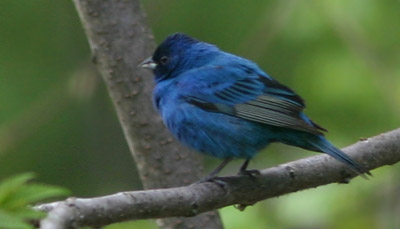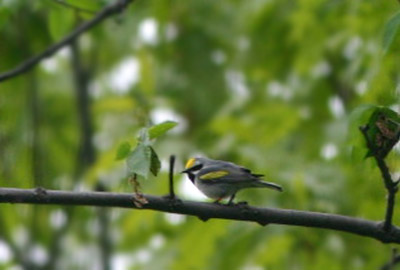Amy of WildBird on the Fly was not the only blogger to figure prominently in this big birding weekend of mine. Charlie also came to town, and he was on a mission. We had a list of three target birds to locate and a prime location for all three. Too bad the capricious, fitful weather didn’t cooperate. We pulled two of the three, but missed the most important one. But I’m getting ahead of myself…

Indigo Bunting
Charlie Moores, for those of you unacquainted with his adventurous oeuvre, is a world birder extraordinaire. One of the few birds found in the northeastern United States not on his life list is not coincidentally one of the most elusive: the Cerulean Warbler. Charlie managed, through some exertion of influence or good karma, to arrange a trip to this area at the height of spring migration, the perfect time to seek out this highly desirable bird. The cerulean has thus far avoided its inevitable fate as a tick on my list as well, so Charlie and I joined forces to track it down. I knew just the place too, the spectacular Sterling Forest State Park. Sterling Forest is famous for breeding populations of Golden-winged, Blue-winged, and Cerulean Warblers. These were our three target species for the day, though we certainly weren’t going to turn any other pulchritudinous passerines away.
The one fly in our avian observation ointment was the threat of imminent rain. Whether the drops were going to fall was never a doubt; the question was merely when and for how long. We set out early to attack our quest with gusto and arrived at Sterling Forest with only a light drizzle to contend with. Within minutes, our first bird, Blue-winged Warbler, was locked in, a buzzy male defending his territory. As we walked the Long Meadow path, we also noted Eastern Kingbird, Swamp Sparrow, Baltimore Oriole, Common Raven, Common Yellowthroat, American Redstart, Northern Waterthrush, and lots of Yellow Warbler in addition to the more prosaic species. Also appearing on cue were Indigo Buntings, those electrifying, eye-searing, unrelentingly blue princes of the genus Passerina. This time of year, these birds are very reliable at Sterling Forest. Finally, we found our second target, a dazzling male Golden-winged Warbler. The golden-wing is one bird I’d never seen before; this gracious fellow gave both of us amazing looks. Flush with success, we decamped to surer Cerulean habitat. That’s when the rain really started.
We really tried, despite the downpour. The park ranger pointed us towards a spot called Sandy Lake said to be perfect for Dendroica cerula. We searched the area thoroughly, heedless of all discomfort in our Cerulean crusade. We even managed to flush some Swainson’s Thrush, a totally new bird for me. But besides the thrush and some Blue-gray Gnatcatchers, we came up empty.
Now, it should be said that Charlie is possessed of a vast global understanding of avifauna that, in all fairness, must be considered true wisdom. He observed that, in conditions of persistent precipitation, breeding birds like our quarry tend to stay quiet and immobile. What we really needed, he explained, was a migrant trap, a flyway or habitat that draws birds on the move. Rain might work to our advantage in such a place by slowing songbirds down. Fortunately, I had an ace up my sleeve, a geological formation molded over millennia to bottle up spring migrants long enough for top-notch birding, a spot in New Jersey so secret, so jealously guarded that I learned about it only a week ago. The Cerulean might not be realistic, but plenty of other warblers would be at Garrett Mountain Reservation.
In an amazing spurt of serendipity, the rain let up just as we approached Garrett Mountain. In an equally amazing bout of befuddlement, I passed Garrett Mountain and traveled to Rifle Camp Park instead. This place was as new to both of us as Garrett Mountain would have been, so I didn’t know if it would live up to the West Paterson hype. I shouldn’t have worried. The warblers were definitely here. It didn’t take much time at all to add Ovenbird, Northern Parula, Black-and-white, Magnolia, Yellow-rumped, Black-throated Blue, and Black-throated Green to the day list. I also spotted a Bay-breasted while Charlie picked up a Canada Warbler. Vireos were hopping too. I not only saw more White-eyed Vireo, but also my first Yellow-throated Vireo, my third new vireo in two weeks for those of you counting at home.
Rifle Camp Park really was well-stocked with avifauna. Flycatchers included Least Flycatcher, Great-crested Flycatcher, Eastern Phoebe, and Eastern Wood-pewee. The thrushes were Veery and Wood Thrush. The tanagers were, of course, splendidly Scarlet. We got brilliant views of all these birds and a few more besides before the rain picked up again. No Cerulean, but I walked away with three life birds and a hell of a time. Don’t worry, Charlie…we’ll get it next time.

Golden-winged Warbler













I’M TRYING TO FIND THE BIRD WITCH EEMS TO MATCH THAT OF THE INDIO-glow( blue ) otherthan the beak be that of much wider,having a blackened stripe around.thanks